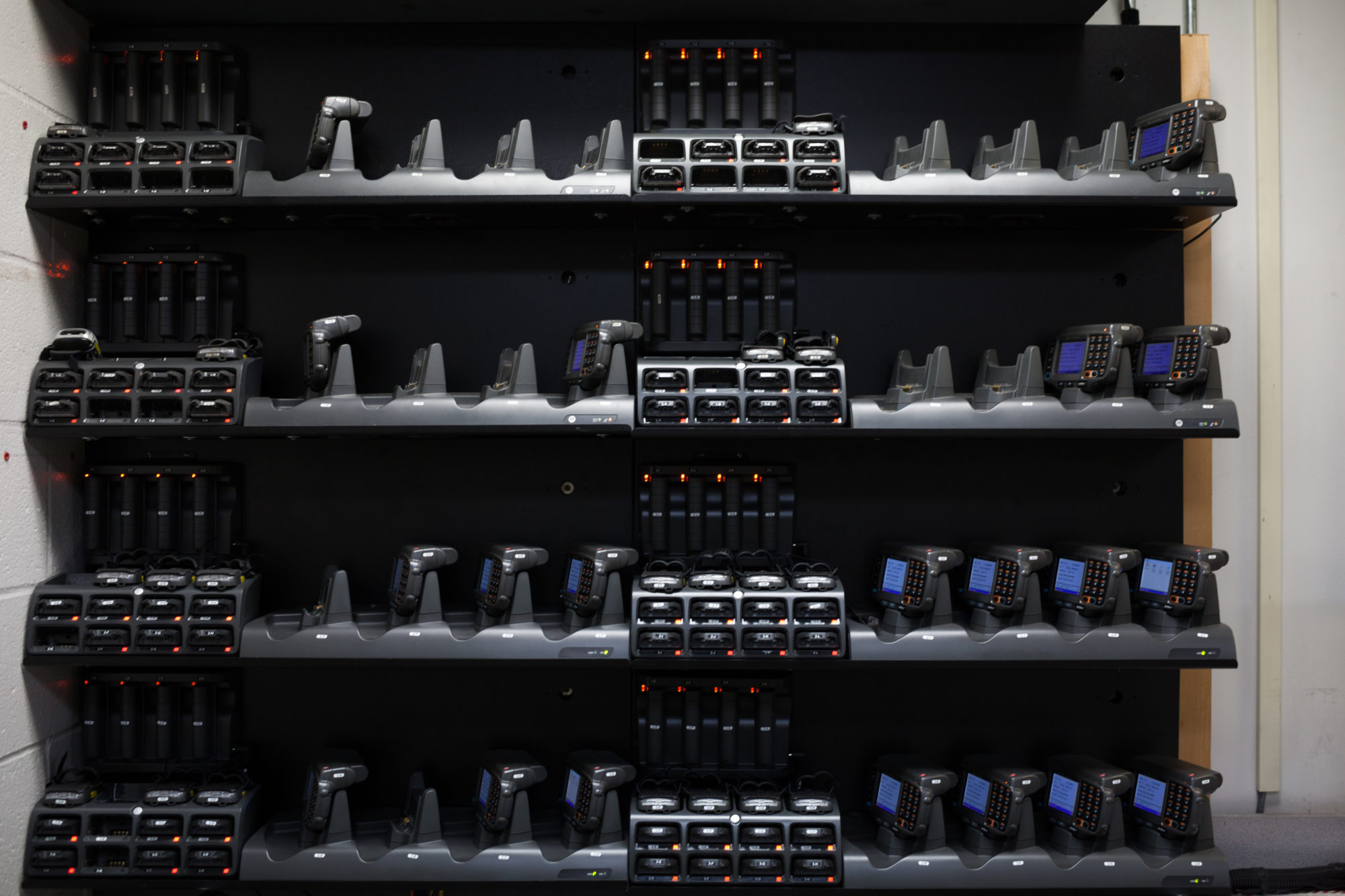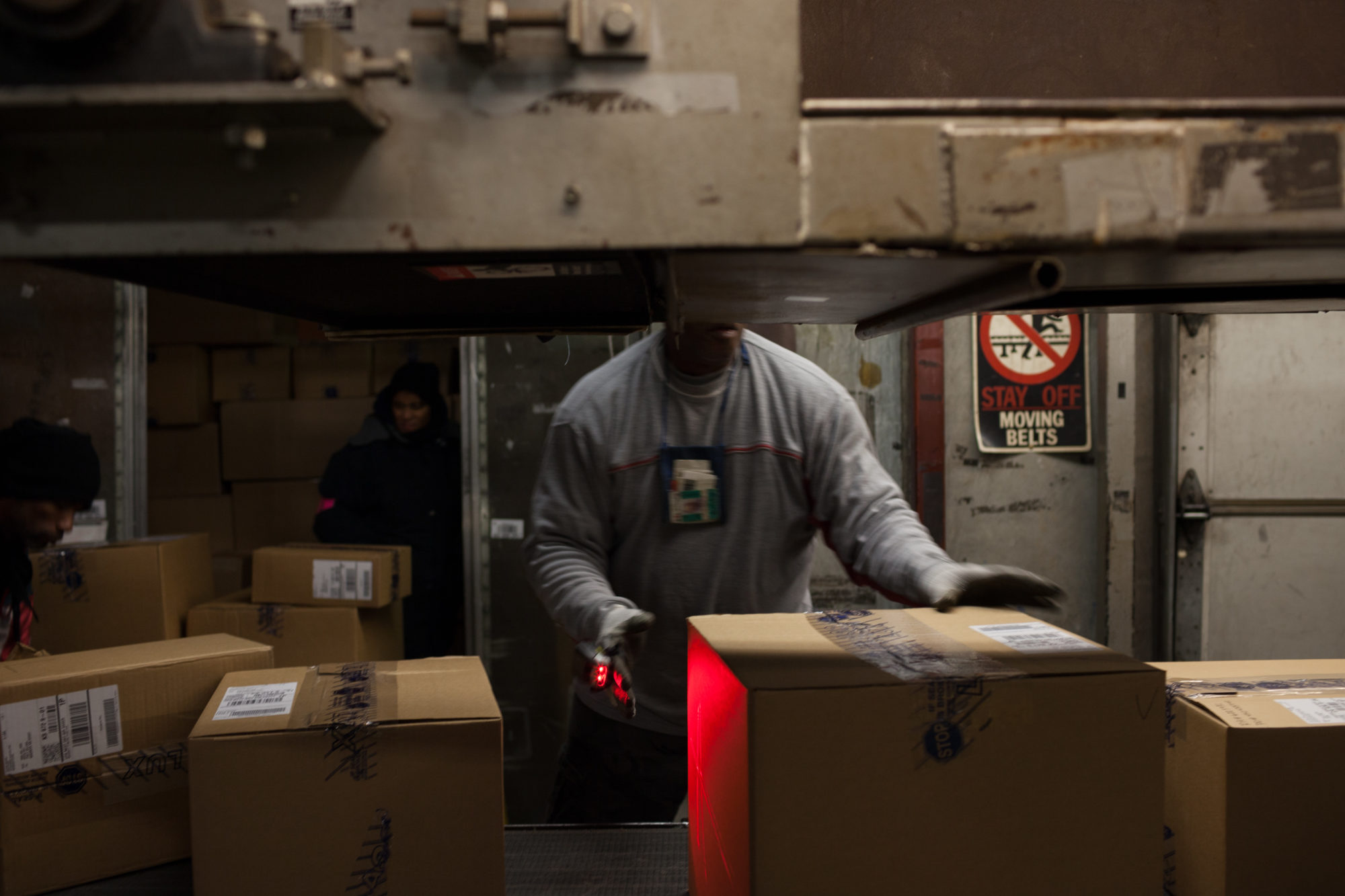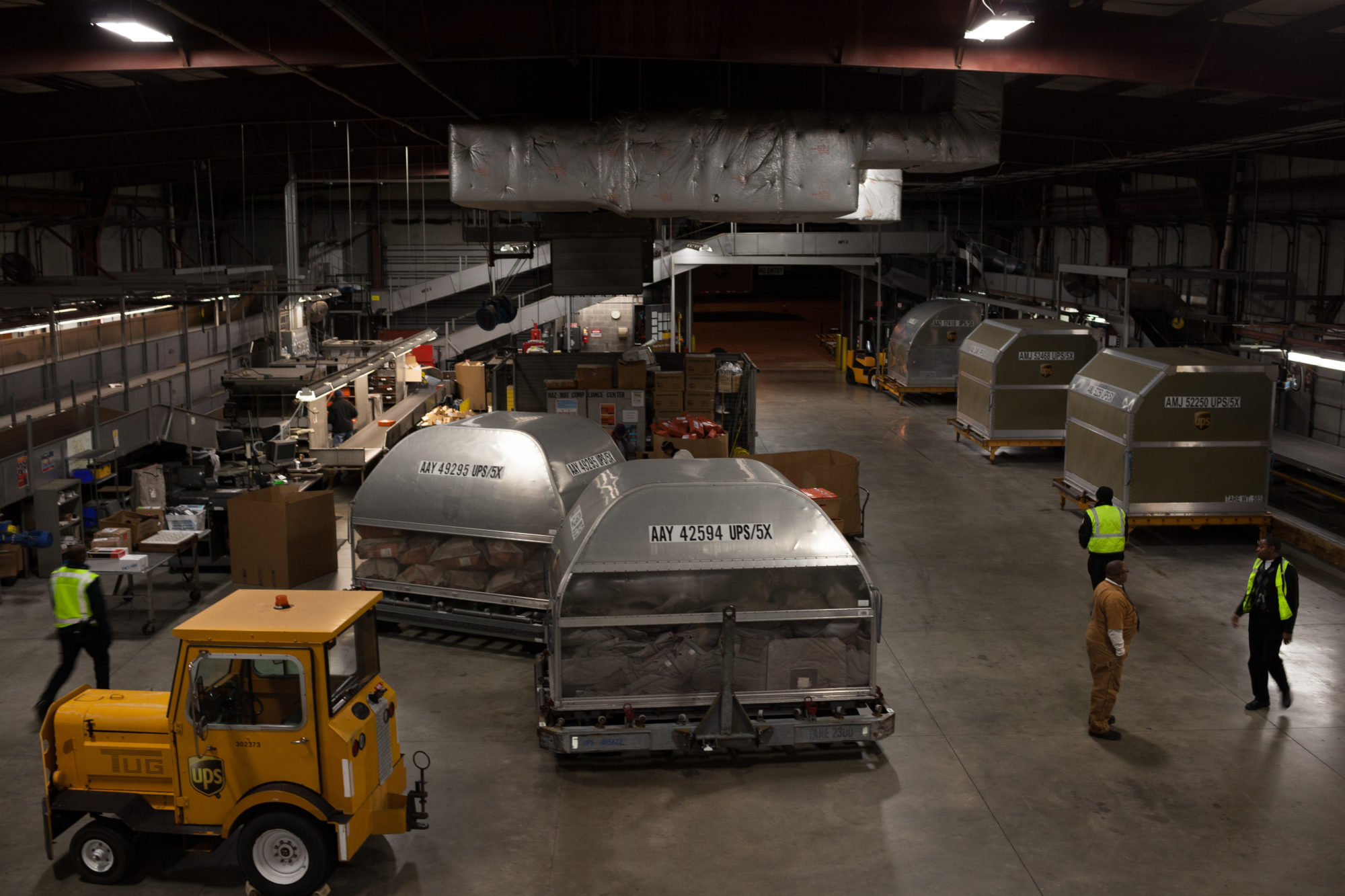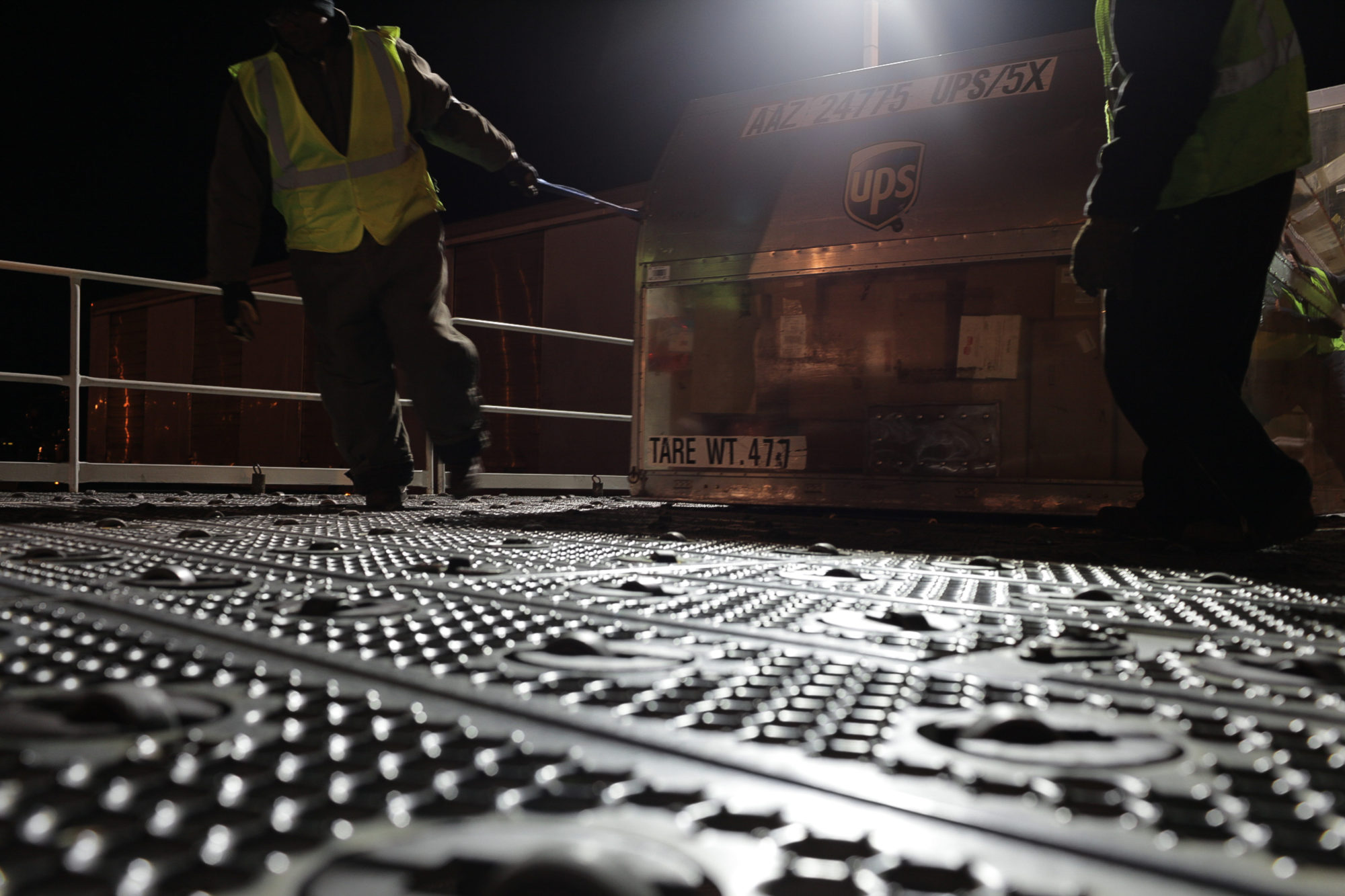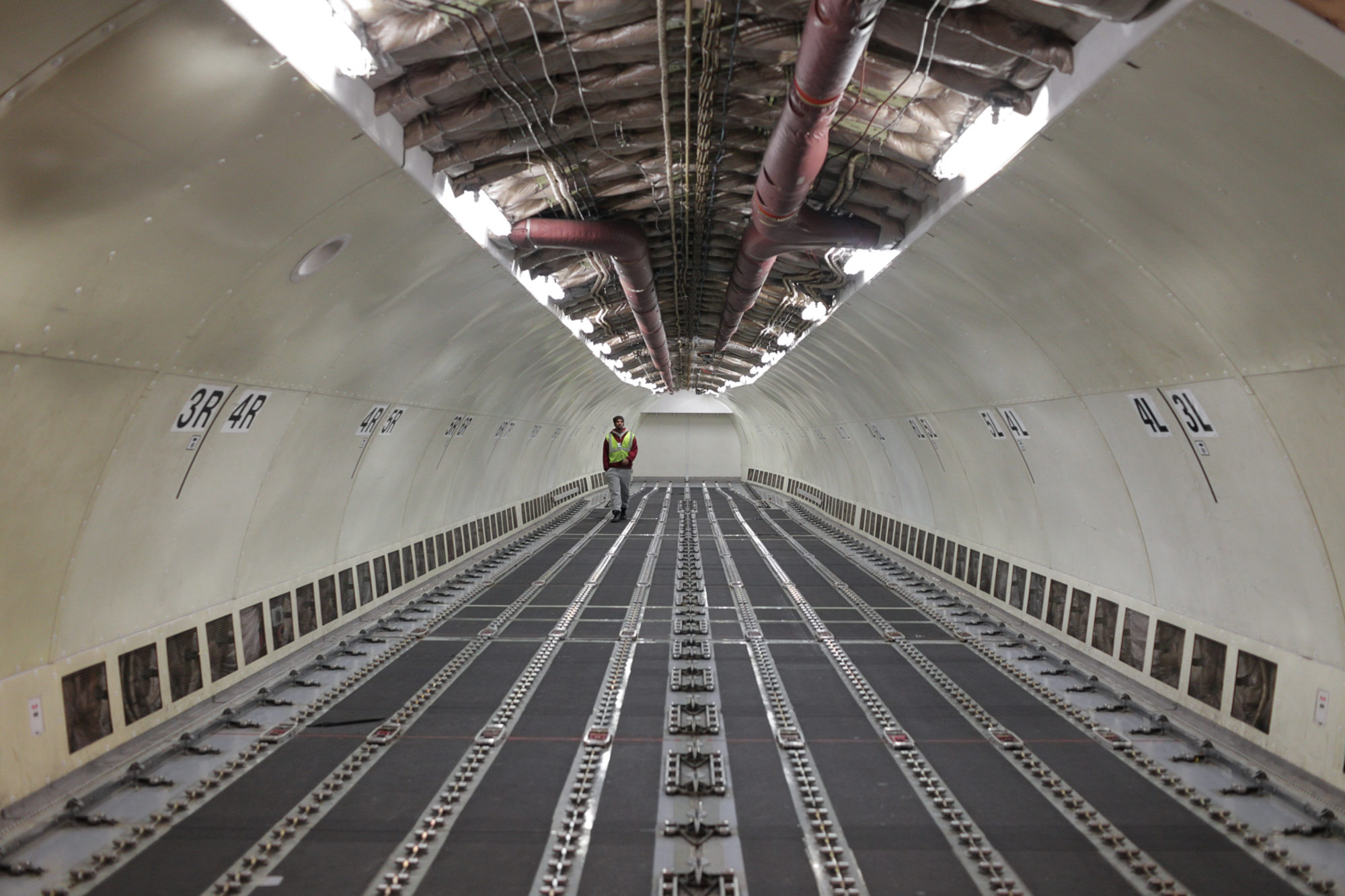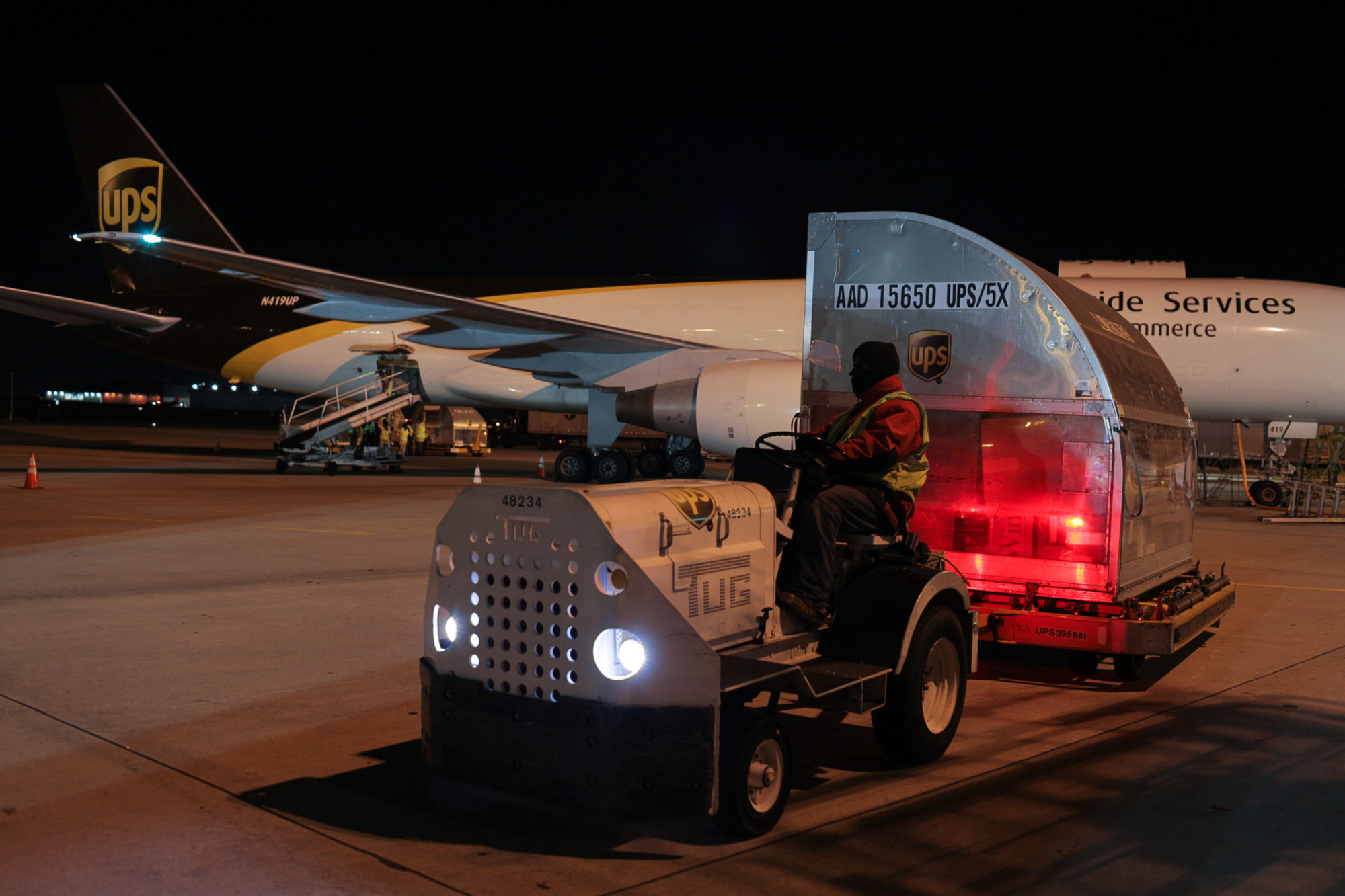Logistics Make the World
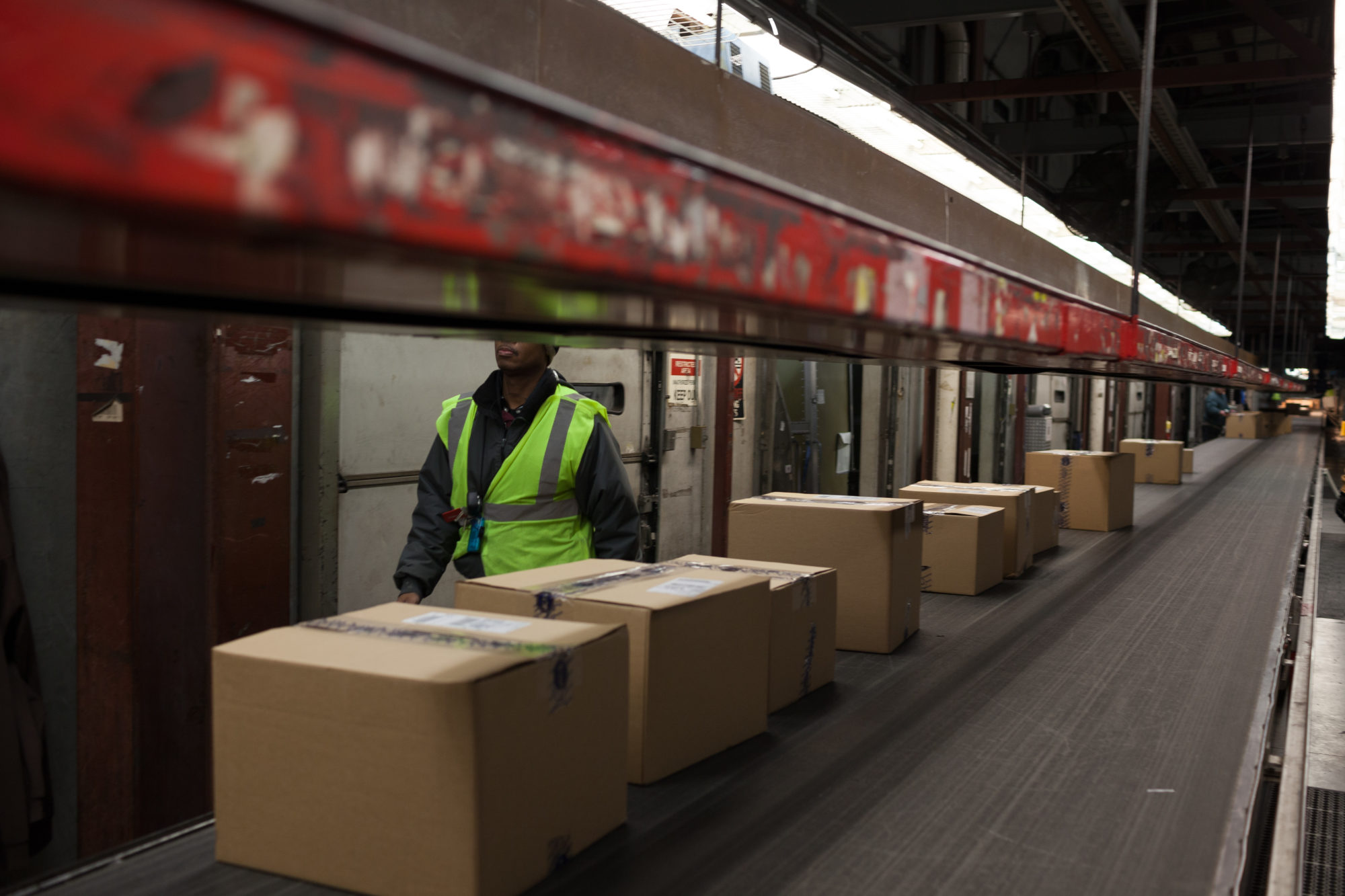
A conveyor belt takes packages for loading into air containers specially designed for UPS aircraft [photo: Dustin Chambers]
In working to overcome the obstacle of time and space to sustain global commerce, logistics remakes the world in its image. Architecture and the human-computer interface reveal points of friction in this process, mediating between territory, body, and network. Global logistics giant UPS is everyone's neighbor, but especially ART PAPERS': UPS corporate headquarters is in the northern part of the greater Atlanta area; across the city, Hartsfield-Jackson International Airport is home to the Atlanta Air Gateway, where packages are loaded onto UPS aircraft to ship to regional and global hubs.
Share:
“Logistics,” according to a recent advertising campaign for the global package delivery company UPS, “makes the world work better.” With that slogan, the company suggests that the services it provides make it easier for people to improve their business by enabling the exchange of goods in a timely, reliable, and transparent manner. UPS touts logistics as “a continuous link that is always in sync” and claims that with logistics, “technology knows right where everything goes.”1 Historically, logistics has been understood as the branch of military science that concerns the planning and coordination of an operation, including provisions for movement, material, and maintenance.2 Logistics is also increasingly used to describe contexts outside the military, especially ones linked to global commerce, transportation, and coordination. The rise of logistics in this sense is coupled with neoliberal trade policies and with the politics of globalization.3 Because improving efficiency, lowering costs, and increasing profit are some of the primary aims of individuals and organizations involved in logistical practices, national borders, labor laws, or certain trade policies can be seen as obstacles to these ambitions.4 And, because logistics has a distinctly spatial dimension to it, its “sites” are increasingly legible as the spaces in which such obstacles are negotiated, reinforced, dismantled, or mutated.5 Such sites are evident in the constituent parts of UPS’ claim that “logistics makes the world work better” and examining each more closely helps reveal the transitions that logistics is forging between the conditions it has inherited and the ones that it is currently producing. It also suggests possible futures that it might yet generate.
A charging station for the ring, wrist, and hand-held scanners used to scan and to track packages at every possible juncture [photo: Dustin Chambers]
BETTER
The appeal to improvement in the UPS slogan is ambiguous. Indeed, what are the specific ways in which logistics improves how the world works? Is it suggesting that logistics helps the world function more smoothly? Or that it improves upon the effectiveness of global labor? In another advertisement from the same campaign, an exasperated fat cat, taking a page from Ned Beatty’s Arthur Jensen in Network, laughs nervously as he confides to a small group of concerned executives that, “Logistics was once the dominion of a very few; the largest and most powerful organizations. Logistics was our secret weapon. Logistics was our black art. The thought that any business, any upstart could access the power of logistics … that’s unthinkable.”6 The “power” of logistics, as offered by UPS, is bureaucratic, temporal, and spatial. Apart from expediting customs processes to allow “crossing borders with ease,” UPS and its logistics work to overcome the obstacle of space and time; in other words, the problem of the shape of the planet. These dynamics illustrate, in David Harvey’s words, “A basic law of capital accumulation” that enables, “Reduction in the cost and time of movement of commodities, people (labor power), money and information through what Marx called ‘the annihilation of space through time.’” He goes on to point out that, “Since distance is measured in terms of time and cost of movement, there is also intense pressure to reduce the frictions of distance by innovations in transportation and communications.”7 It is these sites of friction where logistical thinking is most frequently deployed with its particular emphasis on location, prediction, acceleration, and lubrication.
Within such sites, it is possible to make further distinctions between organizations based on the logistical services they provide. In the case of UPS, the company offers basic assistance to individual customers and additional assembly and repair capabilities to business customers.8 The product mix in UPS’ “worldport” in Louisville, KY, is largely a result of individual customers’ shipping needs. However, in retail distribution systems, like that of the Arkansas-based discounter Walmart, the company determines its own inventory assortment and supply sequences. Rather than delivering packages directly to home addresses, Walmart uses its expansive collection of consumer data to first determine the bulk quantities of merchandise to be delivered to a local distribution center. The materials handling systems and the inventory demand algorithms that control these goods then automatically direct the correct amount (with the help of human operators) to trucks waiting to transport them, in turn, to the proper store location to await the next leg of their journey.
A package handler uses a ring scanner to sort packages based on the zip codes contained in each tracking number (known internally as a “1Z”) [photo: Dustin Chambers]
“Tug” vehicles meet air containers from around the metro area at the Atlanta Air Gateway – one of more than 50 facilities located around the US [photo: Dustin Chambers]
WORK
Logistics, officially, from the Council of Logistics Management is, “The process of planning, implementing, and controlling the efficient, effective flow and storage of goods, services, and related information from point of origin to point of consumption for the purpose of conforming to customer requirements.”9 Making it happen takes force applied over distance: work. A typical logistical configuration concerned with physical distribution of goods involves an entanglement of biological, mechanical, and informational systems. Data about the contents of orders and their destinations (in terms of both location and time) are transmitted through communication networks. They, in turn, guide the process of directing any given order through the various stages along its path, steps that are aided by a combined system of automated or semi-automated handling and sorting machines and various humans who help the process by using their dexterous (and affordable) limbs and digits to make up for the bluntness of the current state of distribution technology. In the Taylorist version of assembly, workers were matched to a job based on their aptitude. With the development of ergonomics, jobs could be adjusted to workers such that physical differences became less of an obstacle. In the space of labor that logistics has defined – the work of assembling or building orders — obstacles to productivity are linked less to the dullness and exhaustion of repetitive actions than through the dullness and exhaustion of traversing the logistical floors, themselves made vast by the attempts to further deny space.10 In other words, in order to overcome time and distance for their customers, logistics organizations amass goods in central distribution centers and fulfillment centers that get larger the more material they contain.11 While the dream of logistics is to eliminate inventory altogether and to suspend items in a constant flow from producer to consumer, the current state demands points of storage and redirection in the form of large flat buildings. Often located in sites where property value encourages horizontality, the physical size of its merchandise nonetheless remains one of the limiting factors in a system’s productivity, primarily because workers are already at their limits in managing the expanse of the logistical surface. To deal with this issue, a company called Kiva Systems, recently acquired by Amazon for $775 million, has developed a system that does not require people to go to things. Instead, machines bring smaller containers of merchandise to workers for finer-grain assembly.
The decisions that determine the destination and constitution of orders are often made automatically through a series of replenishment protocols and algorithms. However, the combination of digital and human systems of labor creates a communication problem. Logistical networks use a system created for computers to be read by computers that we recognize as the bar code. By scanning codes at significant moments in a journey, tracking software establishes a parcel’s location in approximate terms (an interface familiar to anyone who has ever attempted to track a package). People working inside a distribution center are unable to interpret bar codes and must rely on tools for translation — including wearable scanners, hand-held computers, scan-rings, and voice-directed picking systems. These tools allow workers in logistics facilities to keep up with the increasing speed of inventory turnover. Work applied over time, of course, is power.
“Ballmat” roller platforms allow workers to glide air containers weighing several thousand pounds into and out of UPS aircraft. [photo: Dustin Chambers]
WORLD
Between these physical networks and data networks sit mediating elements that translate back and forth for the two and work to overcome certain territorial or spatial obstacles. For wireless communication, one such problem is the shape of the planet. Radio signals, without some form of relay, eventually leave the atmosphere entirely. However, in 1945, Arthur C. Clarke wrote a piece for Wireless World called “Extra-Terrestrial Relays: Can Rocket Stations Give World-wide Radio Coverage?” In it he succinctly summarizes the possibilities of a network of geosynchronous satellites: “A body in such an orbit, if its plane coincided with that of the earth’s equator, would revolve with the earth and would thus be stationary above the same spot on the planet. It would remain fixed in the sky of a whole hemisphere and unlike all other heavenly bodies would neither rise nor set.”12 Clarke suggests that these bodies could be “space-stations,” large, light buildings supporting a range of habitations and functions, and capable of sending and receiving transmissions from the surface of the earth. As illustrated in Clarke’s diagram, “a single station could provide coverage to only half the globe, and for world service, three would be required, though more could be readily utilized.”13 Clarke’s proposal for a network of buildings at fixed points above the earth is not so distant from, for example, Walmart’s network of buildings on the ground, including its retail locations, data centers, and distribution centers. In architectural terms, such space stations would be similar to the lightly constructed, transmission-oriented buildings that Walmart deploys. In the same way that satellites and stars can be difficult to distinguish, so too are the retailer’s distribution buildings hard to parse from those that surround them: hidden in plain sight while undergirding a global logistics network and operating as relays at a global scale.
An employee inspects the interior of a UPS “Browntail” MD-88. UPS is one of the ten largest airlines in the world. [photo: Dustin Chambers]
MAKES
Logistical behavior tends to collapse object and field, figure and ground, as all of the elements in its scope become data to be attended to. For example, an illustration from the journal Army Logistician, in an article called “Modeling the Wholesale Logistics Base,” depicts the interior of the base as a monochromatic volume whose planes are inscribed with a square grid of white lines. In high-contrast black and white, a forklift operator is using his vehicle to transport a two-by-two cube rendered in the same manner as the surroundings. Thus, the objects that are being shuttled through the distribution center merge with the building itself, or vice versa. Rendering surroundings and objects in the same way conflates the two, united in the imagination of the logistician as elements that fit together perfectly and in which each element and each unit of volume and area can be accounted for and modeled. The wireframe is, of course, a familiar means of modeling any kind of three-dimensional space, and the equal grid is an especially nimble means of simulating space. The equal treatment of both environment and objects further erodes the boundary between figure and ground on their mutual journey toward abstraction and the flattening tendencies of calculation. Moreover, the graphic separation of the driver and his forklift are reminders of the increasing incompatibility of humans with such environments.
LOGISITICS
Deborah Cowen links this trajectory to the industrialization of warfare, in which “logistics has come to lead strategy and tactics: it has gone from being the practical afterthought to the calculative process that defines thought. Changes in the material form and social organization of fuel saw logistics gradually become the how that shapes the what.”14 As it is driven by market dynamics, logistics might be seen, if somewhat indirectly, as a reflection of more base and impulsive desires. At what point will the factors that logistics externalizes become obstacles in its own development? As certain balance sheets are reorganized, logistics will play a role in that too. For example, increasing oil prices might make shipping goods from China to the US more expensive than manufacturing them domestically. Or, alternatively, in light of recent EU-Russia trade embargoes, increasing efficiencies and transport technologies could provide ways for farmers to direct their crops to welcoming markets, rather than letting them rot on the ground.15 However, given the ways that logistics defines and deploys global networks of people, goods, and resources, rather than accepting UPS’ claim that “logistics makes the world work better,” it might be more important to recognize that logistics, more simply, makes the world.
An employee uses a Tug to pull an air container into position before loading it into an awaiting “Browntail” airplane. [photo: Dustin Chambers]
References
| ↑1 | UPS, “UPS We Love Logistics Commercial,” YouTube, http://youtu.be/VCh6HnXHKRc |
|---|---|
| ↑2 | James Houston, The Sinews of War: Army Logistics 1775-1953 (Washington, DC: Office of the Chief of Military History, United States Army, 1960), viii. |
| ↑3 | Deborah Cowen, “A Geography of Logistics: Market Authority and the Security of Supply Chains,” Annals of the Association of American Geographers 100, no. 3 (2010): 600-620. |
| ↑4 | Cowen writes, in her study of logistics and borders: “If it is the security of efficient trade flows that animates maritime security today, then the interference that comes from ‘inefficiencies’ like democracy, and the actors that demand it, might themselves be construed as security threats” (Cowen, 616). |
| ↑5 | For more on spaces of logistics, see Keller Easterling, “The New Orgman: Logistics as an Organizing Principle of Contemporary Cities,” in The Cybercities Reader, ed. Stephen Graham (London: Routledge, 2004), 179-184. For further reading, see Clare Lyster, “Landscapes of Exchange: Re-Articulating Site,” in The Landscape Urbanism Reader, ed. Charles Waldheim (New York: Princeton Architectural Press, 2006) 219-238; Charles Waldheim and Alan Berger, “Logistics Landscape,” Landscape Journal 27 (2008): 226; Jesse LeCavalier, “The Restlessness of Objects,” Cabinet 47: Logistics (2012): 90-97. |
| ↑6 | UPS, “UPS — We Love Logistics Commercial — Mr. Big,” UPS Pressroom,www.pressroom.ups.com/Video/UPS%3A+We+Love+Logistics+Commercial+-+Mr.+Big |
| ↑7 | David Harvey, Spaces of Neoliberalization: Towards a Theory of Uneven Geographical Development (Kornwestheim: Franz Steiner Verlag, 2005), 38. |
| ↑8 | John McPhee, Uncommon Carriers (New York: Farrar, Straus and Giroux. 2006), 153-184. |
| ↑9 | W. Bruce Allen, “The Logistics Revolution and Transportation,” Annals of the American Academy of Political and Social Science 553 (September 1997): 107. |
| ↑10 | Sarah O’Connor, “Amazon Unpacked,” Financial Times Weekend Magazine, February 8, 2013. |
| ↑11 | Walmart uses distribution centers to route bulk merchandise to stores, whereas Amazon uses “fulfillment” centers to ship individual orders directly to customers. |
| ↑12 | Arthur C. Clarke, “Extra-Terrestrial Relays: Can Rocket Stations Give World-wide Radio Coverage?,” Wireless World, (October 1945), 305. |
| ↑13 | Clarke, “Extra-Terrestrial Relays,” 306. |
| ↑14 | Deborah Cowen, The Deadly Life of Logistics: Mapping Violence in Global Trade(Minneapolis: University of Minnesota Press, 2014), 30 (original emphasis). |
| ↑15 | “This Apple Was Once Headed to Russia. Not Anymore,” Bloomberg Businessweek, September 15-21, 2014, 13-15. |
